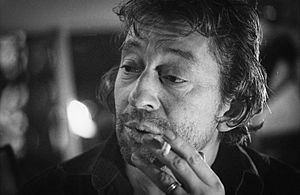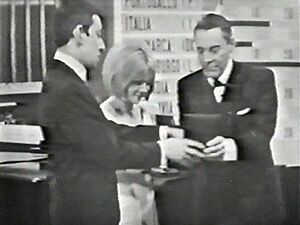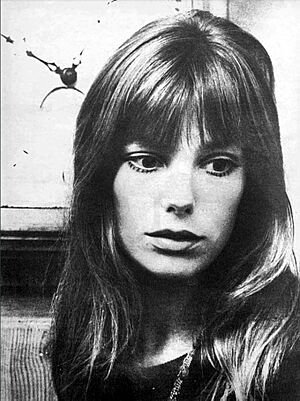Serge Gainsbourg facts for kids
Quick facts for kids
Serge Gainsbourg
|
|
|---|---|

Gainsbourg in 1981
|
|
| Born |
Lucien Ginsburg
2 April 1928 Paris, France
|
| Died | 2 March 1991 (aged 62) Paris, France
|
| Resting place | Montparnasse Cemetery, Paris |
| Other names |
|
| Occupation |
|
| Years active | 1957–1991 |
| Spouse(s) |
Elisabeth "Lize" Levitsky
(m. 1951; div. 1957)Béatrice Pancrazzi
(m. 1964; div. 1966) |
| Partner(s) |
|
| Children | 4, including Charlotte |
| Musical career | |
| Genres | |
| Instruments |
|
| Labels |
|
| Associated acts |
|
Serge Gainsbourg (born Lucien Ginsburg; 2 April 1928 – 2 March 1991) was a famous French singer-songwriter, actor, composer, and director. He is considered one of the most important figures in French pop music. Gainsbourg was known for his unique and sometimes surprising songs that sparked discussions in France.
His music explored many styles, from early jazz and chanson to later rock, reggae, and electronic sounds. Gainsbourg's diverse musical approach makes him hard to categorize. However, he is widely recognized as one of the world's most influential popular musicians. He wrote over 550 songs, which have been performed by many different artists. His lyrics often featured clever wordplay, humor, and unexpected ideas. After his death in 1991, Gainsbourg's music became legendary in France. He gained a strong following worldwide, with hits like "Je t'aime... moi non plus" and "Bonnie and Clyde".
Contents
Who Was Serge Gainsbourg?
Early Life and Family
Serge Gainsbourg was born Lucien Ginsburg in Paris, France, on 2 April 1928. His parents, Joseph and Olga Ginsburg, were Russian Jewish immigrants. His mother, Olga, was a mezzo-soprano singer. His father, Joseph, was a classically trained pianist.
Joseph and Olga met in Crimea and fled to Paris after the Russian Revolution. Joseph played piano in bars and casinos, while Olga sang. Serge had an older brother, Marcel, who passed away young, and an older sister, Jacqueline, and a twin sister, Liliane.
The family lived in working-class areas of Paris and became French citizens in 1932. Joseph taught Serge and Liliane to play the piano. At age 12, Serge began studying music at the École Normale de Musique de Paris.
Serge's childhood was greatly affected by World War II and the German occupation of France. As a Jewish child, he had to wear a yellow badge, which left a lasting impression on him. This experience later inspired some of his creative work. During the war, his family had to hide and use false documents to stay safe from persecution.
After the war, the family returned to Paris. Serge studied art at prestigious schools like Beaux-Arts de Paris. There, he met his first wife, Elisabeth "Lize" Levitsky, and they married in 1951. He also served in the military for a year, where he spent time playing guitar. Later, he taught music and painting at a school for orphaned children. Hearing their stories of wartime persecution influenced his songwriting.
Starting a Music Career
Serge Gainsbourg felt uninspired by teaching art. He started playing piano in bars, sometimes filling in for his father. He became a pianist at a drag cabaret club called Madame Arthur. When joining a songwriting society, he decided to change his first name to Serge. He chose Gainsbourg as his last name, inspired by the English painter Thomas Gainsborough.
Gainsbourg was inspired by the bold and humorous songs of Boris Vian. He began performing his own songs, including "Le Poinçonneur des Lilas." This song describes the boring daily life of a Paris Métro ticket collector. After his debut, he got a regular spot at the club and was discovered by a talent agent, Jacques Canetti, who helped him tour.
His first album, Du chant à la une !... (1958), was not a commercial success. However, it won an award and received praise from Boris Vian. His next album, N° 2 (1959), also struggled. Gainsbourg started acting in films, often playing "nasty characters." His first commercial hit came in 1960 with "L'Eau à la bouche," the title song from a film he scored. His third album, L'Étonnant Serge Gainsbourg (1961), included "La Chanson de Prévert," one of his best-known songs from that time. He also wrote "La Javanaise" for singer Juliette Gréco, which became a classic.
Eurovision and Pop Hits
Gainsbourg became a key figure in the yé-yé movement, a style of French pop music. He wrote many hit songs for young female singers like Brigitte Bardot, Petula Clark, and France Gall. He met France Gall through their record label, Philips Records. Their collaboration produced hits like "N'écoute pas les idoles" and "Laisse tomber les filles."
One of their most famous songs was "Poupée de cire, poupée de son," which won the Eurovision Song Contest 1965 for Luxembourg. This song featured clever wordplay, a signature of Gainsbourg's lyrics.
Gainsbourg married Françoise-Antoinette "Béatrice" Pancrazzi on 7 January 1964. They had two children, a daughter named Natacha and a son named Paul. They divorced in 1966.
His album Gainsbourg Percussions (1964) was inspired by African musicians like Miriam Makeba and Babatunde Olatunji. This album was praised for being ahead of its time by including world music influences. Between 1965 and 1966, Gainsbourg composed music for animated shorts called Marie-Mathematics.
Collaborations and Famous Songs
In 1967, Gainsbourg wrote the script and soundtrack for the TV film Anna. He also composed "The Sand and the Soldier" for the Israel Defense Forces. Another of his songs, "Boum-Badaboum," came in fifth place at the Eurovision Song Contest 1967.
Gainsbourg had a close relationship with Brigitte Bardot. He wrote the songs "Je t'aime... moi non plus" and "Bonnie and Clyde" for her. The first version of "Je t'aime" was not released at the time due to its very personal nature. Bardot's album Brigitte Bardot Show 67 included four songs by Gainsbourg, such as the playful "Comic Strip" and "Bonnie and Clyde." His own album, Initials B.B. (1968), featured these duets and was recorded in London.
After his relationship with Bardot ended, Gainsbourg met English singer and actress Jane Birkin in 1968. They starred together in the film Slogan (1969). Their relationship lasted over a decade, and they had a daughter, Charlotte Gainsbourg, in 1971.
Birkin and Gainsbourg recorded a new version of "Je t'aime... moi non plus." This song became very popular but also caused a lot of discussion and was even banned from radio in some places because of its bold style. It was included on their joint album Jane Birkin/Serge Gainsbourg.
Creative Concept Albums
After the success of "Je t'aime... moi non plus," Gainsbourg decided to create more serious and artistic works. In 1971, he released his concept album Histoire de Melody Nelson. This album tells a story about a man and a young woman named Melody Nelson after a car accident. It featured Gainsbourg's unique half-spoken, half-sung vocals, funk-inspired music, and beautiful string arrangements. Though it didn't sell many copies at first, it is now considered one of his most important works.
In May 1973, Gainsbourg had a heart attack. His next album, Vu de l'extérieur (1973), was not a concept album. He also wrote all the songs for Jane Birkin's first solo album, Di doo dah. In 1975, Gainsbourg released Rock Around the Bunker, an album with a 1950s rock and roll sound. It explored themes related to Nazi Germany and World War II, drawing from his childhood experiences.
The following year, he released another concept album, L'Homme à tête de chou (The Cabbage Head Man). This album marked his first exploration into reggae music, a style he would continue to use in his next two albums. In 1976, Gainsbourg also directed his first film, Je t'aime moi non plus, starring Jane Birkin.
Exploring Reggae Music
In 1978, Gainsbourg traveled to Kingston, Jamaica, to record a reggae album. He worked with famous Jamaican musicians like Sly and Robbie and The I-Threes, who were backing singers for Bob Marley. This made him one of the first white musicians to record a reggae album in Jamaica.
The album, Aux armes et cætera (1979), was incredibly popular, selling over a million copies. However, it also caused controversy because the title track was a reggae version of the French national anthem, "La Marseillaise." Some people criticized this, and Gainsbourg even received threats. At one concert, he famously sang the anthem a cappella to an angry crowd, stating its true meaning was revolutionary.
Jane Birkin and Gainsbourg separated in 1980, but they remained close friends. Gainsbourg continued to write songs for her. His first live album, Enregistrement public au Théâtre Le Palace (1980), showed his reggae-influenced style. He also wrote a novella called Evguénie Sokolov. His final reggae album, Mauvaises nouvelles des étoiles (1981), was recorded in The Bahamas. During this time, he also wrote hit songs for other artists, like "Manureva" for Alain Chamfort.
Later Years and Legacy
In 1982, Gainsbourg contributed songs to French rock singer Alain Bashung's album Play blessures. His second film as a director, Équateur (1983), was set in colonial French Equatorial Africa.
His album Love on the Beat (1984) moved towards an electronic, new wave sound. In March 1984, he publicly burned part of a 500-French-franc bill on television to protest high taxes.
Gainsbourg's final partner was model Caroline Paulus, known as Bambou. They had a son, Lucien, in 1986, who is now a musician known as Lulu. Gainsbourg's 1986 film Charlotte for Ever starred him and his daughter Charlotte.
His sixteenth and final studio album, You're Under Arrest (1987), kept the funky new wave sound and added hip hop elements. It was a concept album about a narrator and his girlfriend in New York City, with an anti-drug message.
In November 1988, Gainsbourg was deeply moved when a boys' choir, dressed like him, sang a tribute on a TV show. His health declined in later years, and he underwent liver surgery in 1989. He continued to write for other artists, including "White and Black Blues" for Joëlle Ursull, the French entry in the Eurovision Song Contest 1990. He also wrote all the lyrics for singer Vanessa Paradis's album Variations sur le même t'aime (1990). His last album of original material was Birkin's Amours des feintes in 1990.
Serge Gainsbourg passed away from a heart attack at his home on 2 March 1991, at the age of 62. He was buried in the Jewish section of the Montparnasse Cemetery in Paris. French President François Mitterrand praised him, calling him "our Baudelaire, our Apollinaire... He elevated the song to the level of art." His daughter Charlotte described him as a generous poet who played with words and had a childlike wonder.
Legacy and Influence

Since his death, Serge Gainsbourg's music has become legendary in France. Many French artists, like the bands Air and Stereolab, and singers Benjamin Biolay and Thomas Fersen, have named him as an influence. He also gained fans in English-speaking countries, including artists like Jarvis Cocker of Pulp, Beck, Michael Stipe of R.E.M., and Alex Turner of Arctic Monkeys.
His Parisian home, where he lived from 1969 to 1991, is now a celebrated shrine. The outside walls are covered in graffiti dedicated to him, along with photos of important people in his life. In 2008, Paris's Cité de la Musique held an exhibition called Gainsbourg 2008 to honor his work.
Gainsbourg was also seen as a fashion icon, known for his sharp suits, white shoes, and unique style. In 2010, a biographical film about his life, Gainsbourg (Vie héroïque), was released. It won several awards, including Best Actor for Eric Elmosnino, who played Gainsbourg as an adult.
Discography
Studio albums
- Du chant à la une !... (1958)
- N° 2 (1959)
- L'Étonnant Serge Gainsbourg (1961)
- Serge Gainsbourg N° 4 (1962)
- Gainsbourg Confidentiel (1964)
- Gainsbourg Percussions (1964)
- Initials B.B. (1968)
- Jane Birkin/Serge Gainsbourg (1969)
- Histoire de Melody Nelson (1971)
- Vu de l'extérieur (1973)
- Rock Around the Bunker (1975)
- L'Homme à tête de chou (1976)
- Aux armes et cætera (1979)
- Mauvaises nouvelles des étoiles (1981)
- Love on the Beat (1984)
- You're Under Arrest (1987)
Filmography as director
- Je t'aime moi non plus (1976)
- Équateur (1983)
- Springtime in Bourges (1987)
- Stan the Flasher (1990)
See also
 In Spanish: Serge Gainsbourg para niños
In Spanish: Serge Gainsbourg para niños








